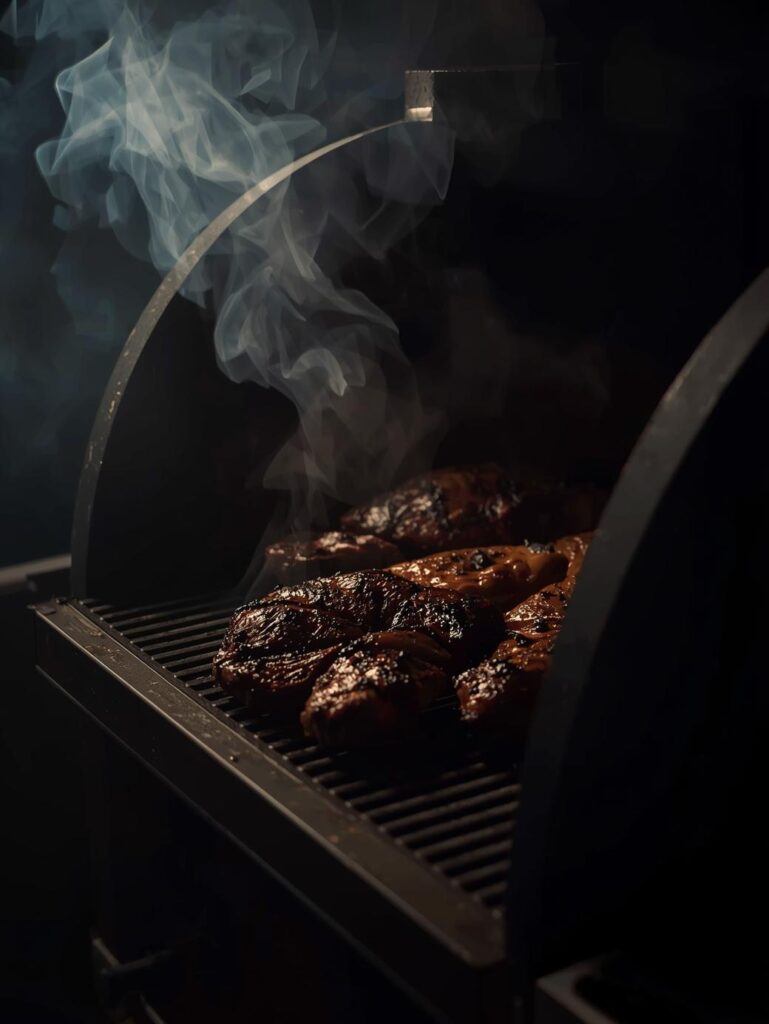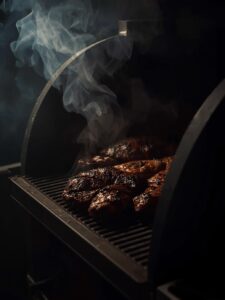Expert’s Note: This guide is part of our comprehensive Ultimate Grill & Smoker Maintenance Guide. Bookmark this resource for quick troubleshooting solutions.
PELLET SMOKER TROUBLESHOOTING GUIDE: SOLVE COMMON PROBLEMS FAST
“Nothing kills a barbecue buzz faster than a pellet smoker that won’t start, won’t stay hot, or quits mid-cook. This guide will help you diagnose and fix the most common issues in minutes, not hours.”
Pellet Smoker Troubleshooting Guide – The Meat Master USA
Keep this guide handy on your phone for quick diagnostics when your smoker acts up during a cook.
There’s a special kind of frustration that comes from a pellet smoker malfunctioning. One moment you’re anticipating perfectly smoked brisket, the next you’re staring at a cold grill, falling temperatures, or—worst of all—error codes you don’t understand. Unlike a simple charcoal grill, a pellet smoker is a precision machine combining mechanical, electrical, and software components. This complexity means more potential failure points, but also more specific, diagnosable problems.
This guide is organized by symptom, not by component. When your smoker acts up, you’re dealing with the symptom first. We’ll walk you through a logical diagnostic flow chart in your mind, from the simplest (and most common) fixes to the more complex, helping you restore heat and save your cook.
🚨 CRITICAL: THE TROUBLESHOOTING MINDSET
Before you start turning screws, adopt this mindset:
Safety First: Always unplug the smoker before inspecting electrical components or the auger.
Start Simple: 80% of problems are caused by 20% of the issues—often fuel, power, or simple blockages.
One Change at a Time: Make a single adjustment or fix, then test. If you change three things at once, you won’t know what worked.
Listen and Observe: Your smoker gives clues. Unusual noises, specific error codes, and the behavior of the smoke and flame are all vital evidence.
🔧 THE TROUBLESHOOTING FLOW: START HERE
When anything goes wrong, run through this quick checklist first. It solves a surprising number of issues.
✅ The Pre-Flight Checklist (5-Minute Diagnostic)
- Power Source: Is the smoker plugged in? Is the outlet working? Try a different appliance in the same outlet.
- Power Switch: Is the master power switch on the back or side of the smoker in the “ON” position?
- Hopper Lid: Is it securely closed? Most smokers have a safety switch that prevents operation if the lid is open.
- Pellet Supply: Are there pellets in the hopper? Is the auger buried, or is there a “void” or bridge? (Gently poke the pellets with a wooden spoon to collapse any air pockets).
- Circuit Breaker: Check your home’s GFCI outlet or circuit breaker. Pellet smokers can sometimes trip them.
🎯 SYMPTOM 1: SMOKER WON’T TURN ON / NO POWER
The Problem: You press the button, and… nothing. No lights, no sounds, no signs of life.
🔍 Diagnostic Steps:
- Verify Power Source: This is the most common culprit. Use a phone charger or lamp to confirm the outlet is live. If it’s a GFCI outlet, press the reset button.
- Check the Power Cord: Inspect the entire cord for any cuts, crimps, or burn marks.
- Inspect the Fuse: Many controllers have an inline fuse on the power cord or inside the control box. Consult your manual for its location and how to check it with a multimeter.
- Test the Safety Switch: The hopper lid switch is a common failure point. With the smoker unplugged, you can carefully bypass it temporarily for testing (consult your manual) to see if the unit powers on.
🛠️ Likely Solutions:
- Reset GFCI outlet or home circuit breaker.
- Replace the blown fuse with an identical type and rating.
- Replace a faulty hopper lid safety switch.
🔥 SYMPTOM 2: FAILURE TO IGNITE / NO FIRE
The Problem: The smoker powers on, the auger turns, but the pellets never light. The temperature reading never rises.
🔍 Diagnostic Steps:
- Listen for the Igniter: During the startup cycle, you should hear a faint “clicking” from the fire pot—the sound of the hot rod heating up. No click often means a failed hot rod or its connection.
- Check for Pellet Feed: Are pellets actually making it into the fire pot? During ignition, you should see a small pile forming.
- Inspect the Hot Rod: UNPLUG THE SMOKER. Remove the fire pot. The hot rod should be clean and free of heavy ash buildup. Using a multimeter, you can check for continuity. A reading of OL (Open Loop) means it’s burned out and needs replacement.
- Look for Airflow Blockages: A clogged fire pot from previous ash can smother the initial flame. Ensure the combustion fan is running and the air intake isn’t blocked.
🛠️ Likely Solutions:
- Thoroughly vacuum the fire pot before your next cook.
- Replace a burned-out hot rod. This is a common wear item.
- Ensure you are using high-quality, dry pellets. Damp pellets won’t ignite easily.
Pro Tip: Keep a small butane torch or a heat gun as a backup ignition source. If your hot rod fails mid-cook, you can manually light the pellets in the fire pot to save the day while you wait for a replacement part.
🌡️ SYMPTOM 3: TEMPERATURE FLUCTUATIONS & THE DREADED “STALL”
The Problem: The smoker struggles to reach the set temperature, or the temperature swings wildly (e.g., set for 225°F, but it bounces between 180°F and 280°F).
🔍 Diagnostic Steps:
- The “Ash Bog”: This is the #1 cause of temperature stalls. As ash builds up in the fire pot, it insulates the hot rod and fire, causing inefficient combustion and eventually smothering the flame.
- Dirty Temperature Probe: The RTD (Resistance Temperature Detector) probe tells the controller how hot it is inside. If it’s coated in grease and carbon, it gives a false, low reading, causing the controller to over-feed pellets and over-shoot the temperature.
- Poor-Quality Pellets: Pellets with high bark content or inconsistent density burn unevenly, causing heat spikes and drops.
- Environmental Factors: High winds, cold ambient temperatures, and rain can all affect the smoker’s ability to maintain temperature.
🛠️ Likely Solutions:
- Vacuum the fire pot clean before every long cook.
- Clean the RTD temperature probe with a brass brush or steel wool until it shines.
- Use a thermal blanket in cold or windy weather.
- Switch to a premium brand of hardwood pellets with low dust content.
🚫 SYMPTOM 4: AUGER JAM / MOTOR FAILURE
The Problem: You hear a loud grinding noise, a humming from the auger motor with no movement, or the controller gives an “Auger Jam” error.
🔍 Diagnostic Steps:
- Identify the Sound: – Grinding: Often a foreign object (rock, piece of metal) in the auger tube. – Humming: The motor is trying to turn but can’t. This is often a jam or a sheared shear pin.
- Check the Shear Pin: Most augers have a shear pin or a plastic coupling designed to break if the auger jams, protecting the expensive motor. Locate it (usually where the auger shaft meets the motor) and see if it’s broken.
- Inspect Pellet Quality: Damp pellets swell and turn into a cement-like mass inside the auger tube.
- Test Auger Manually: UNPLUG THE SMOKER. Try to turn the auger manually from the motor end. If it doesn’t budge, it’s severely jammed.
🛠️ Likely Solutions:
- Clear the jam using a long, flexible nylon rod. Never use a metal coat hanger as it can damage the auger flighting.
- Replace a sheared shear pin with an exact match—never use a bolt, as it will not break and could burn out the motor.
- Always store pellets in a waterproof container.
- Vacuum “fines” (sawdust) out of the hopper regularly.
💨 SYMPTOM 5: EXCESSIVE SMOKE OR POOR SMOKE QUALITY
The Problem: The smoker is producing thick, white, bitter smoke (like a damp campfire) instead of the desired Thin Blue Smoke, or no visible smoke at all.
🔍 Diagnostic Steps:
- Understand Smoke Color: – Thick White Smoke: Inefficient combustion, often at low temperatures or with poor airflow. – No Visible Smoke: Often normal at higher temperatures (e.g., above 275°F) where combustion is very efficient. – Thin Blue Smoke (Ideal): Clean, efficient combustion at the right temperature and airflow.
- Check the P-Flow Setting: Many modern controllers have a “P-Setting” or Smoke Setting that controls the pause between auger feeds. A setting that’s too high (e.g., P7) can smother the fire, creating dirty smoke.
- Check Airflow: Ensure the exhaust vent is open and the combustion fan is running smoothly.
🛠️ Likely Solutions:
- For cleaner smoke, run the smoker at a slightly higher temperature (250°F+) for the first 60-90 minutes of the cook to establish clean combustion.
- Adjust the P-Setting. A lower number (P0-P2) means more consistent fuel feed and often cleaner burns at lower temps.
- Ensure you are using 100% hardwood pellets, not blends with artificial oils or fillers.
⚠️ SYMPTOM 6: ERROR CODES DECODED
Error codes are your smoker’s way of telling you exactly what’s wrong. While they vary by brand, here are the most common ones:
🔄 ER1 / ERR / AUG: Auger-Related Error
Meaning: The controller detected the auger is not turning as expected.
Fix: Check for a jam, a sheared pin, or a failing auger motor.
🔥 ER2 / IGN: Ignition Failure
Meaning: The smoker failed to light within the designated startup time (usually 15-20 minutes).
Fix: Check the hot rod, ensure pellets are feeding, and vacuum the fire pot.
🌡️ ER3 / HHH / LLL: Temperature Probe Fault
Meaning: The RTD probe is reading a temperature that is impossibly high (HHH) or low (LLL).
Fix: Unplug the smoker and check the wiring connection to the probe. The probe itself may have failed and need replacement.
Essential Tools for Troubleshooting: Be prepared for common issues:
✅ PROACTIVE MAINTENANCE: THE BEST TROUBLESHOOTING IS PREVENTION
The vast majority of the problems listed above are preventable with a consistent, simple maintenance routine.
📅 The Golden Maintenance Rule:
Vacuum the fire pot and burn box before every long cook. This single habit will prevent about 80% of all ignition and temperature-related issues.
🛡️ The Pellet Quality Commandment:
Your fuel is everything. Invest in high-quality, low-dust, 100% hardwood pellets and store them in a sealed container in a dry place. Cheap pellets are the root cause of auger jams, dirty smoke, and inconsistent burns.
🔍 The Monthly Deep Dive:
- Clean the RTD temperature probe until it’s shiny.
- Vacuum out the hopper completely to remove sawdust “fines.”
- Inspect the auger for any signs of wear or corrosion.
- Check all gaskets for a tight seal.
📚 Related Maintenance Topics
🎯 CONCLUSION: REGAIN YOUR CONFIDENCE
A malfunctioning pellet smoker can feel like a complex mystery, but it’s almost always one of a handful of common, fixable issues. By working through this symptom-based guide, you can move from panic to solution in a matter of minutes. Remember the core principles: start with the simple stuff (power, pellets, fire pot), listen to your machine, and don’t be afraid to get your hands a little dirty.
Keep this guide bookmarked on your phone. The next time an error code flashes or your temperature plummets, you’ll have the knowledge not just to fix it, but to understand why it happened, making you a more confident and capable pitmaster.
Never Get Stuck Mid-Cook Again
Master your equipment with our complete library of maintenance and troubleshooting guides.



